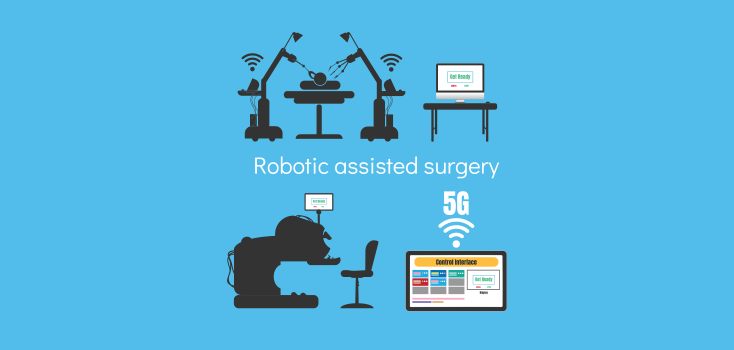
When machines communicate wirelessly over 5G
5G is far more than the successor to LTE: Medical device manufacturers can use it to build their own networks and thus promote factory automation. In addition, 5G provides a medical Internet of Things through low latency and high reliability.
As a rule, new smartphones were at the focus of the Mobile World Congress (MWC) in Barcelona. But in February, a medical application caused quite a stir: the first live surgery over a 5G network. Specifically, it was a streaming in real time between a team of doctors in the Hospital Clinic and Dr. med. Antonio de Lacy, Head of Gastrointestinal Surgery, in the main auditorium of the MWC. During the demonstration, de Lacy used moving image transmission markers, which were immediately seen by the surgical team in the clinic. Almost simultaneously, the first 5G tele-operation took place in China: a Parkinson’s disease patient was implanted with a neurostimulator in the brain at the Plagh Hospital in Beijing. The doctor was in a clinic on the island of Hainan, 2700 km away from Beijing.
However, not all functionalities are available in one go. According to Dr. med. Andreas Müller, the Head of Communication and Network Technology at Bosch Corporate Research, in the current version of the standard, only the high data rates for the classic consumer business are covered. Only in Release 16, which will be available by the end of 2019, will be included other functionalities that are of interest to industrial application.
The Klinikum rechts der Isar of the Technical University of Munich has already dealt with the possibilities of 5G. The Clinic and Outpatient Clinic for Surgery of the TU Munich conducted a 12-month pilot study with 5G prototypes in 2017/18. Three medical use cases were evaluated: On the one hand, this was the already mentioned tele-surgery. The physical separation between the operating physician and the technical equipment has the general charm that professionals could offer medical assistance to operations in remote areas as well as operations. However, it was found that 5G can not bring all of its benefits at the same time. For the transmission of CT data, for example, a large bandwidth with a high data transfer rate is needed. In contrast, low latency is important for tele-operations. Therefore, one has to decide what is important for the particular application.
The first considerations were that in the OP one can use devices such as endoscopes wirelessly and without cables, because 5G promises high data transfer rates and low latency. According to Professor Jan Stallkamp, head of the Fraunhofer PAMB, a wireless OP not only allows a general improvement in ergonomics, but also efficient processes in the surgical setup. In the closed intervention room 5G is competing among other things with the new Wi-Fi standard Wi-Fi6. These systems offer similar high data rates and low transmission times, but lack the mobility and seamless transition between local and mobile networks. 5G ensures continuous data collection both inside and outside the clinic during process-related changes of location.
In the future, Stallkamp sees further application scenarios for 5G: “In principle, 5G makes it possible to develop medical devices without intelligence. The intelligence, as a part of the software, can be moved away from the terminal, for example, into the cloud; with all the advantages of a central system and data management. The lifecycle of devices could be consistently monitored at 5G, allowing specific approaches such as predictive maintenance to increase their uptime and reduce maintenance costs. This is only possible if a highly reliable radio link is available nationwide. However, that’s also a regulatory nightmare.”
References:
Websites
https://medizin-und-technik.industrie.de/digitalisierung/wenn-maschinen-ueber-5g-drahtlos-kommunizieren/ (retrieved on 14.9.19)

